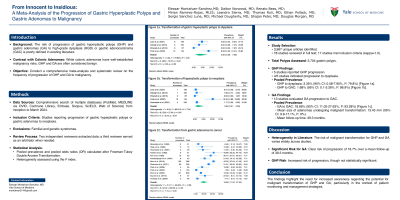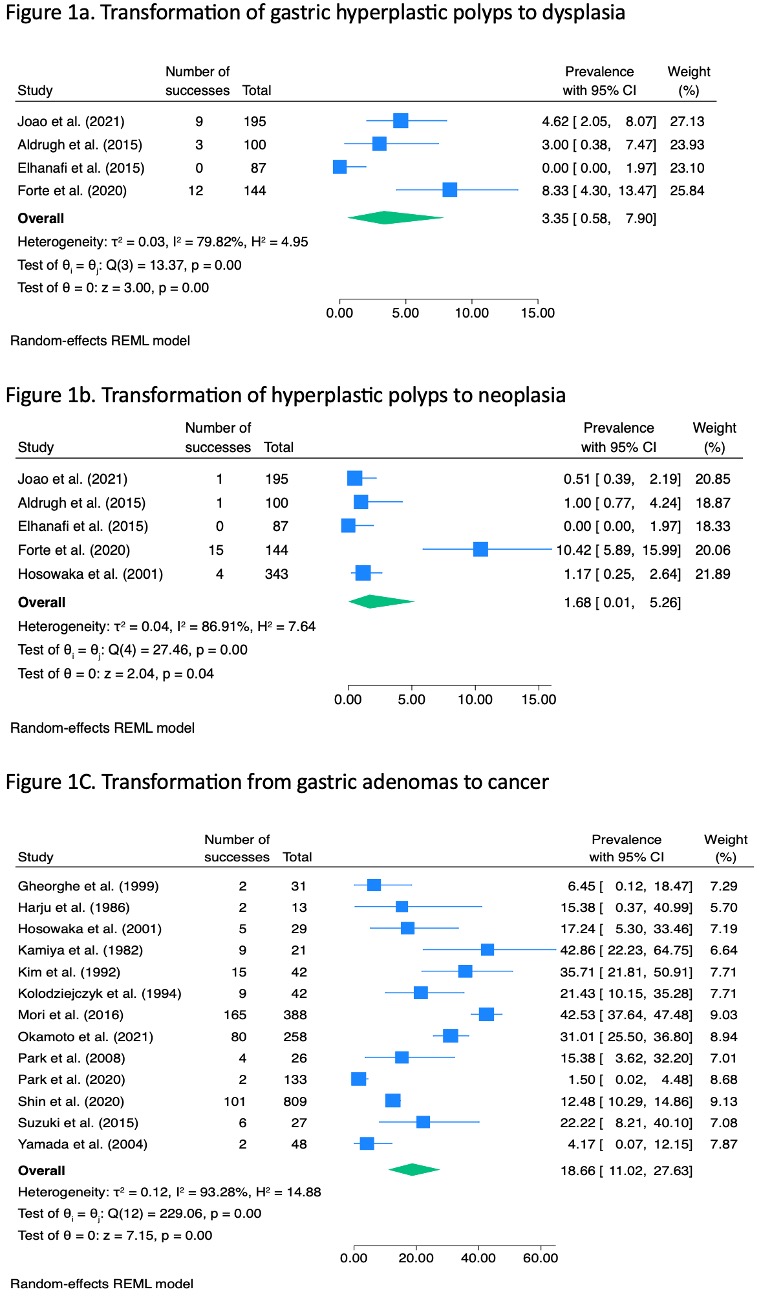Monday Poster Session
Category: Stomach
P3325 - From Innocent to Insidious: A Meta-Analysis of the Progression of Gastric Hyperplastic Polyps and Gastric Adenomas to Malignancy
Monday, October 28, 2024
10:30 AM - 4:00 PM ET
Location: Exhibit Hall E

Has Audio

Eleazar Enrique Montalvan-Sanchez, MD
Yale Digestive Diseases
New Haven, CT
Presenting Author(s)
Eleazar Enrique. Montalvan-Sanchez, MD1, Dalton A.. Norwood, MD2, Renato Beas, MD3, Mirian Ramirez, 4, Leandro Sierra, MD5, Hector Caceres, MD6, Thomas Ruli, MD7, Ethan D. Pollack, MS, MD6, Sergio A. Sánchez-Luna, MD8, Michael Dougherty, MD9, Shajan Peter, MD8, Douglas Morgan, MD8
1Yale Digestive Diseases, New Haven, CT; 2UAB Minority Health & Health Equity Research Center, The University of Alabama at Birmingham Heersink School of Medicine, Birmingham, AL; 3Washington University School of Medicine in St. Louis / Barnes-Jewish Hospital, St. Louis, MO; 4Ruth Lilly Medical Library, Indiana University School of Medicine, Indianapolis, IN; 5Cleveland Clinic Foundation, Cleveland, OH; 6University of Alabama at Birmingham Heersink School of Medicine, Birmingham, AL; 7University of Alabama at Birmingham, Birmingham, AL; 8Basil I. Hirschowitz Endoscopic Center of Excellence, The University of Alabama at Birmingham Heersink School of Medicine, Birmingham, AL; 9University of North Carolina at Chapel Hill School of Medicine, Chapel Hill, NC
Introduction: The risk of progression of gastric hyperplastic polyps (GHP) and gastric adenomas (GA) to high-grade dysplasia (HGD) or gastric adenocarcinoma (GAC) is poorly defined in the literature. In contrast to colonic adenomas, GHP and GA are generally regarded as benign lesions. We performed a comprehensive meta-analysis and systemic review on the frequency of progression of GHP and GA.
Methods: A comprehensive search of multiple databases including PubMed, MEDLINE (OVID), Cochrane Library, Embase, Scopus, SciELO and Web of Science was conducted from inception to March 2024 for all published studies that reported progression of gastric hyperplastic polyps or gastric adenomas to neoplasia. Familial and genetic syndromes were excluded. Two independent reviewers extracted data, with a third author served as arbitrator as needed. Pooled prevalence and pooled odds ratios (OR) were calculated after Freeman-Tukey Double Arcsine Transformation. Heterogeneity was assessed using the I2 index.
Results: 3987 unique articles were identified, 78 studies were identified for full text review and 17 studies were eligible for inclusion with full agreement between investigators (kappa=1.0). Overall, 3704 gastric polyps were assessed. Five studies reported the progression of GHP, with 4/5 studies reporting progression of GHP to dysplasia. The pooled prevalence of GHP evolving to dysplasia was 3.35% (95% CI: 0.58-7.90%, I2: 79.8%) [Figure 1a]. The pooled prevalence of progression from GHP to GAC was 1.68% (95% CI: 0.1-5.26%, I2: 86.9%) in the 5 studies [Figure 1b]. GHP size was not reported in most of the studies. Thirteen studies were included in the evaluation of the progression of GA into GAC. The pooled prevalence of progression was 18.66% (95% CI: 11.02-27.63%, I2: 93.28%) [Figure 1C]. Notably, the mean size of adenomas that underwent malignant transformation was 13.43mm (95% CI: 9.8-17.1%, I2: 0%), and the mean follow-up time across all studies was 39.3 months.
Discussion: The literature regarding the malignant transformation of GHP and GA risk is heterogeneous. GA have a clear risk of progression of 18.7% with a mean follow-up of 39.3 months. GHP have an increased, yet not statistically significant, risk of progression.

Disclosures:
Eleazar Enrique. Montalvan-Sanchez, MD1, Dalton A.. Norwood, MD2, Renato Beas, MD3, Mirian Ramirez, 4, Leandro Sierra, MD5, Hector Caceres, MD6, Thomas Ruli, MD7, Ethan D. Pollack, MS, MD6, Sergio A. Sánchez-Luna, MD8, Michael Dougherty, MD9, Shajan Peter, MD8, Douglas Morgan, MD8. P3325 - From Innocent to Insidious: A Meta-Analysis of the Progression of Gastric Hyperplastic Polyps and Gastric Adenomas to Malignancy, ACG 2024 Annual Scientific Meeting Abstracts. Philadelphia, PA: American College of Gastroenterology.
1Yale Digestive Diseases, New Haven, CT; 2UAB Minority Health & Health Equity Research Center, The University of Alabama at Birmingham Heersink School of Medicine, Birmingham, AL; 3Washington University School of Medicine in St. Louis / Barnes-Jewish Hospital, St. Louis, MO; 4Ruth Lilly Medical Library, Indiana University School of Medicine, Indianapolis, IN; 5Cleveland Clinic Foundation, Cleveland, OH; 6University of Alabama at Birmingham Heersink School of Medicine, Birmingham, AL; 7University of Alabama at Birmingham, Birmingham, AL; 8Basil I. Hirschowitz Endoscopic Center of Excellence, The University of Alabama at Birmingham Heersink School of Medicine, Birmingham, AL; 9University of North Carolina at Chapel Hill School of Medicine, Chapel Hill, NC
Introduction: The risk of progression of gastric hyperplastic polyps (GHP) and gastric adenomas (GA) to high-grade dysplasia (HGD) or gastric adenocarcinoma (GAC) is poorly defined in the literature. In contrast to colonic adenomas, GHP and GA are generally regarded as benign lesions. We performed a comprehensive meta-analysis and systemic review on the frequency of progression of GHP and GA.
Methods: A comprehensive search of multiple databases including PubMed, MEDLINE (OVID), Cochrane Library, Embase, Scopus, SciELO and Web of Science was conducted from inception to March 2024 for all published studies that reported progression of gastric hyperplastic polyps or gastric adenomas to neoplasia. Familial and genetic syndromes were excluded. Two independent reviewers extracted data, with a third author served as arbitrator as needed. Pooled prevalence and pooled odds ratios (OR) were calculated after Freeman-Tukey Double Arcsine Transformation. Heterogeneity was assessed using the I2 index.
Results: 3987 unique articles were identified, 78 studies were identified for full text review and 17 studies were eligible for inclusion with full agreement between investigators (kappa=1.0). Overall, 3704 gastric polyps were assessed. Five studies reported the progression of GHP, with 4/5 studies reporting progression of GHP to dysplasia. The pooled prevalence of GHP evolving to dysplasia was 3.35% (95% CI: 0.58-7.90%, I2: 79.8%) [Figure 1a]. The pooled prevalence of progression from GHP to GAC was 1.68% (95% CI: 0.1-5.26%, I2: 86.9%) in the 5 studies [Figure 1b]. GHP size was not reported in most of the studies. Thirteen studies were included in the evaluation of the progression of GA into GAC. The pooled prevalence of progression was 18.66% (95% CI: 11.02-27.63%, I2: 93.28%) [Figure 1C]. Notably, the mean size of adenomas that underwent malignant transformation was 13.43mm (95% CI: 9.8-17.1%, I2: 0%), and the mean follow-up time across all studies was 39.3 months.
Discussion: The literature regarding the malignant transformation of GHP and GA risk is heterogeneous. GA have a clear risk of progression of 18.7% with a mean follow-up of 39.3 months. GHP have an increased, yet not statistically significant, risk of progression.

Figure: Meta-analysis results depicting the progression of gastric lesions.
(1a) Pooled prevalence of gastric hyperplastic polyps (GHP) evolving to dysplasia was 3.35% (95% CI: 0.58-7.90%, I²: 79.8%).
(1b) Pooled prevalence of progression from GHP to gastric adenocarcinoma (GAC) was 1.68% (95% CI: 0.1-5.26%, I²: 86.9%) across 5 studies.
(1c) Evaluation of 13 studies on the progression of gastric adenomas (GA) to GAC revealed a pooled prevalence of 18.66% (95% CI: 11.02-27.63%, I²: 93.28%).
(1a) Pooled prevalence of gastric hyperplastic polyps (GHP) evolving to dysplasia was 3.35% (95% CI: 0.58-7.90%, I²: 79.8%).
(1b) Pooled prevalence of progression from GHP to gastric adenocarcinoma (GAC) was 1.68% (95% CI: 0.1-5.26%, I²: 86.9%) across 5 studies.
(1c) Evaluation of 13 studies on the progression of gastric adenomas (GA) to GAC revealed a pooled prevalence of 18.66% (95% CI: 11.02-27.63%, I²: 93.28%).
Disclosures:
Eleazar Montalvan-Sanchez indicated no relevant financial relationships.
Dalton Norwood indicated no relevant financial relationships.
Renato Beas indicated no relevant financial relationships.
Mirian Ramirez indicated no relevant financial relationships.
Leandro Sierra indicated no relevant financial relationships.
Hector Caceres indicated no relevant financial relationships.
Thomas Ruli indicated no relevant financial relationships.
Ethan Pollack indicated no relevant financial relationships.
Sergio A. Sánchez-Luna indicated no relevant financial relationships.
Michael Dougherty indicated no relevant financial relationships.
Shajan Peter: Olympus – Consultant.
Douglas Morgan: American Molecular Laboratory – Investigator-initiated study, company donated analysis. Freenome, Inc – Site PI, industry CRC diagnostics trial. Panbela Therapeutics – NCI-funded study, company donated study drug to the University. Thorne Research, Inc – NCI-funded study, company donated study drug to the University.
Eleazar Enrique. Montalvan-Sanchez, MD1, Dalton A.. Norwood, MD2, Renato Beas, MD3, Mirian Ramirez, 4, Leandro Sierra, MD5, Hector Caceres, MD6, Thomas Ruli, MD7, Ethan D. Pollack, MS, MD6, Sergio A. Sánchez-Luna, MD8, Michael Dougherty, MD9, Shajan Peter, MD8, Douglas Morgan, MD8. P3325 - From Innocent to Insidious: A Meta-Analysis of the Progression of Gastric Hyperplastic Polyps and Gastric Adenomas to Malignancy, ACG 2024 Annual Scientific Meeting Abstracts. Philadelphia, PA: American College of Gastroenterology.
